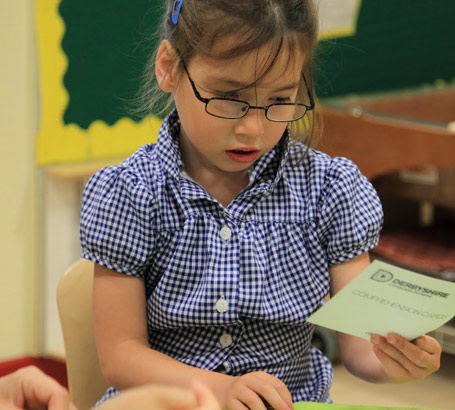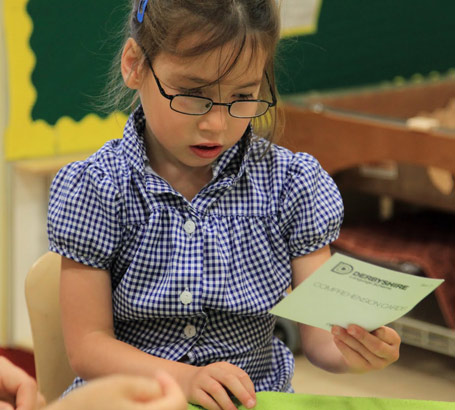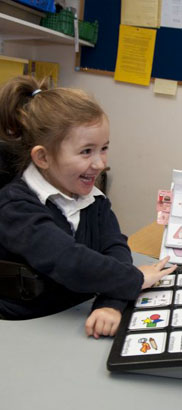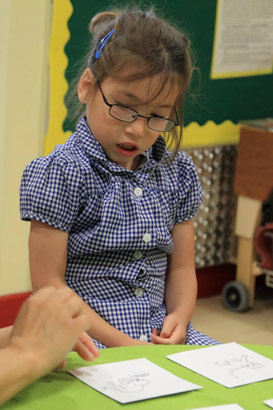
For Piaget, cognitive development was an aspect of children's adaptation to their physical and social environment in order to survive. Over time, exposure to new features of the environment led to further adaptation. Piaget understood children's cognitive development as linear, progressing through four increasingly complex stages towards mature (formal operational) thinking.

- Sensorimotor: child receives sensory information through physical exploration. From only reflex responses at birth, babies become goal orientated with experience, gain understanding of object permanence, and cause and effect; they begin to use symbols in play (for example, objects that stand for something else) and in language (words that stand for objects).
- Pre-operational: children's thinking is intuitive, based on what they sense and experience. They are egocentric, gradually developing an awareness of others' perspectives.
- Concrete operational: Children are capable of organising information (for example,. categorising, sorting, ordering), and begin to use numbers and understand conservation. They can reason based on a present situation, but cannot generalise or think abstractly.
- Formal operational (abstract): children can reason from abstracts, allowing them to use concepts and generalisations and to think flexibly. They can solve problems and act based on extrapolations of what they know.
For extended definitions of these forms of thinking, click here

- Children are born with a basic mental structure allowing them to learn;
- The child is a lone scientist (thinker) [This was criticised in later research];
- Children as active participants in extending their own learning;
- Readiness to learn [criticised; see Vygotsky's zone of proximal development;]
- Stages of development [disproved by subsequent research;]
- Schemas;
- Egocentrism;
- Object permanence;
- Conservation;
- Environments that encourage children to learn through exploration.
Find out how High Scope, the early childhood education approach started in the US in the 1960s based on Piaget's theories, has built on them. Summarise its key tenets
The idea that knowledge is actively constructed by the child is one of the central tenets of Piagetian theory. [His] theory
that children think and reason in different ways at different developmental stages is no longer accepted. [However] his idea
that physical interaction with the world is a critical part of knowledge construction has been supported. The basis of cognition
is indeed in sensory-motor learning, as Piaget proposed. However, sensory-motor representations are not replaced by symbolic
ones. Rather, they are augmented by knowledge gained through action, language, pretend play and teaching.
Goswami and Bryant, 2007

Piaget assumed that children's problem-solving approaches were the same for all problems. However, research shows that children choose different strategies depending on the goal of the activity and its context (Rogoff, 1990).

Piaget proposed we construct knowledge into schemes or schemas. Schemas are prototypical associations of perceptions, ideas and actions which we use to interpret and understand the world.
New knowledge is either:
- Assimilated: associated with existing schemas, or
- Accommodated: associated with a new schema.
Through the process of equilibration – the need to make meaning of our experiences – schemas which are negated by new information are abandoned.
Piaget proposed that schemas are qualitatively different at each of his stages. For example, at the sensorimotor stage, schemas are largely based on sensory experience.

For many children with special educational needs, particularly those with profound and multiple learning disabilities, caregivers will need to help them to assimilate and accommodate their experiences through the exploitation of touch, taste and smell
Tilstone and Layton, 2004

Notwithstanding criticisms, educators of children with SLD/PMLD/CLDD find some of Piaget's principles helpful, including:
- The notion of the child as an active learner;
- The importance of independent activity;
- The role of exploratory activity, including object manipulation, in promoting cognitive activity and development;
- The ideas behind the Piaget's stages (for example, sensorimotor cognitive development) for children with SLD/PMLD/CLDD. (McLinden, 2012 Training and Development Agency for Schools, undated).
Taking each of these points as headings, think of a child with SLD/PMLD/CLDD you know and describe how their learning is and could be structured to reflect each of these points.

Goswami, U. and Bryant, P. (2007) Children's Cognitive Development and Learning. London: Esmée Fairbairn Foundation / University of
Cambridge.
Rogoff, B. (1990) Apprenticeship in Thinking: Cognitive development in social contexts. Oxford: Oxford University Press.
Tilstone, C. and Layton, L. (2004) Child Development and Teaching Pupils with Special Educational Needs. London: Routledge.

Training and Development Agency for Schools (undated) Every Child Matters: Children's needs and development (Self-study task 4). London: TDA.
Westermann, G., Thomas, M.S.C. and Karmiloff-Smith, A. (2010) Neuroconstructivism. In: U. Goswami (ed.) The Handbook
of Cognitive Development (2nd edn). Oxford: Blackwell.
Slater, A., Hocking, I. and Loose, J. (2003) Theories and issues in child development. In: A. Slater and J.G. Bremner (eds)
An Introduction to Developmental Psychology. Oxford: Blackwell.
Thelen, E. and Smith, L.B. (2006) Dynamic systems theory. In: Damon, W.D. and Lerner, R.M. (eds) Handbook of Child Psychology
(vol. 1): Theoretical models of human development (6th edn). New York, NY: John Wiley.